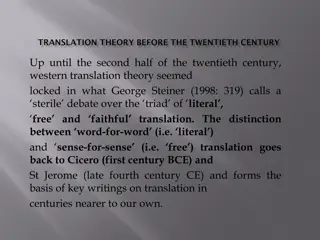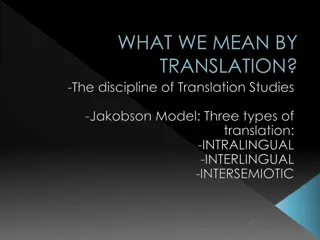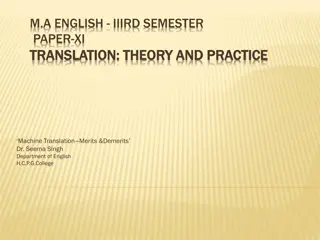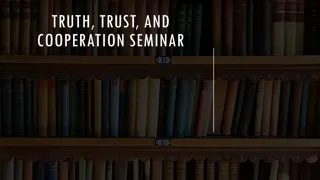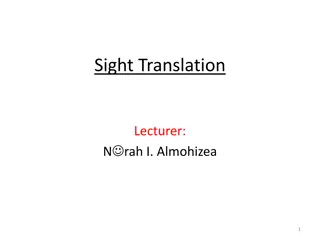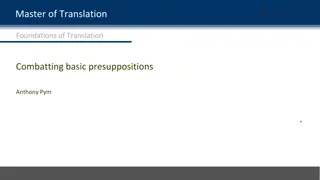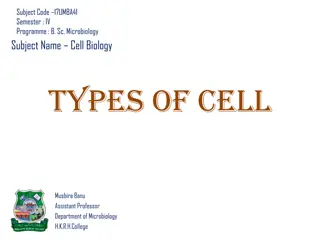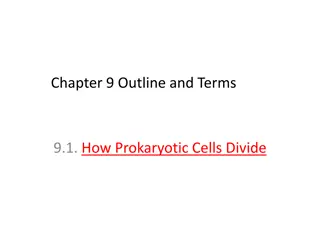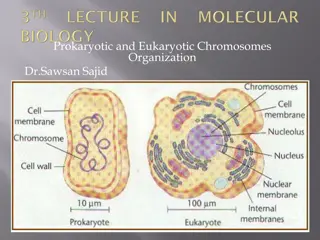
Eukaryotic Translation
Explore the intricate process of eukaryotic translation, including mRNA modifications, peptide chain initiation, elongation, and termination. Learn about the distinct features of eukaryotic translation compared to prokaryotes, such as the role of initiation factors and release factors. Dive into the steps involved in translation and discover the key factors that drive protein synthesis in eukaryotic cells.
Download Presentation

Please find below an Image/Link to download the presentation.
The content on the website is provided AS IS for your information and personal use only. It may not be sold, licensed, or shared on other websites without obtaining consent from the author. If you encounter any issues during the download, it is possible that the publisher has removed the file from their server.
You are allowed to download the files provided on this website for personal or commercial use, subject to the condition that they are used lawfully. All files are the property of their respective owners.
The content on the website is provided AS IS for your information and personal use only. It may not be sold, licensed, or shared on other websites without obtaining consent from the author.
E N D
Presentation Transcript
Eukaryotic translation Eukaryotic translation Eukaryotic mRNAs are characterized by two post-transcriptional modifications: the 5-terminal 7methyl-GTP cap and the 3-terminal poly(A) tail . The 7methyl-GTP cap is essential for mRNA binding by eukaryotic ribosomes and also enhances the stability of these mRNAs by preventing their degradation by 5-exonucleases. The poly(A) tail enhances both the stability and translational efficiency of eukaryotic mRNAs. The Shine Dalgarno sequences found at the 5- end of prokaryotic mRNAs are absent in eukaryotic mRNAs. Peptide Chain Initiation in Eukaryotes Eukaryotic protein synthesis is considerably more complex than prokaryotic protein synthesis. The eukaryotic initiator tRNA is a unique tRNA functioning only in initiation. Like the prokaryotic initiator tRNA, the eukaryotic version carries only Met. However, unlike prokaryotic f-Met-tRNAifMet, the Met on this tRNA is not formylated. The eukaryotic initiator tRNA is usually designated tRNAiMet, with the i indicating initiation.
Eukaryotes Peptide Chain Elongation Peptide Chain Elongation in Eukaryotes Resembles the Prokaryotic Process Eukaryotic peptide elongation occurs in very similar fashion to the process in prokaryotes. An incoming aminoacyl- tRNA enters the ribosomal A site while peptidyl-tRNA occupies the P site. Peptidyl transfer then occurs, followed by translocation of the ribosome one codon further along the mRNA. Two elongation factors, eEF1 and eEF2, mediate the elongation steps. eEF1 consists of two components: eEF1A and eEF1B. eEF1A is the eukaryotic counterpart of EF-Tu; it serves as the aminoacyl-tRNA binding factor and requires GTP. eEF1B is the eukaryotic equivalent of prokaryotic EF-Ts; it catalyzes the exchange of bound GDP on eEF1GDP for GTP so that active eEF1GTP can be regenerated. EF2 is the eukaryotic translocation factor. eEF2 (like its prokaryotic kin, EF-G) binds GTP, and GTP hydrolysis accompanies translocation. Eukaryotic Peptide Chain Termination Eukaryotic Peptide Chain Termination Requires Just One Release Factor Whereas prokaryotic termination involves three different release factors (RFs), just one RF is sufficient for eukaryotic termination. Eukaryotic RF binding to the ribosomal A site is GTP-dependent, and RFGTP binds at this site when it is occupied by a termination codon. Then, hydrolysis of the peptidyl-tRNA ester bond, hydrolysis of GTP, release of nascent polypeptide and deacylated tRNA, and ribosome dis sociation from mRNA .




